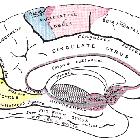Sulcus calcarinus

desc}} ==
{{Information |description = |Other fields 1 = {{Information field|Name={{Ucfirst:{{Plate}}}}|Value=757}} |date = {{Other date|before|1858}} |source = *{{cite book |year=1918 |author=[[:en:Henry Gray|Henry Gray]] |title=Anatomy of the Human Body }} (See "{{Section header|Book}}" section below) *{{Gray"s Anatomy/link|757}} |author = {{Creator:Henry Vandyke Carter}} |other_versions = |permission = }} == {{Section header|Book}} == {{Gray"s Anatomy}} =={{int:license-header}}== {{PD-scan|PD-old-100-1923}} [[Category:Gray"s Anatomy plates|0757]] [[Category:Neuroanatomy]] [[Category:Brodmann area]] [[Category:Motor cortex]] [[Category:Gyri]] [[Category:Sulcus (neuroanatomy)]] [[Category:Visual cortex]] [[Category:Somatosensory cortex]] [[Category:Primary m

The calcarine fissure, or calcarine sulcus, is located on the medial surface of the occipital lobe and divides the visual cortex (a.k.a. calcarine cortex) into two.
The fissure is variable in course (figure 1), but is generally oriented horizontally, anteriorly joining the parieto-occipital fissure, and posteriorly reaching a variable distance toward or even beyond (and onto the lateral surface) of the occipital pole.
Below the fissure is the infracalcarine region, comprised of the fusiform gyrus and lingual gyrus, whilst above the fissure is the cuneus.
Buried deep in the fissure is the calcarine artery, a branch of the posterior cerebral artery, which supplies the region.
Calcarine derives from the Latin word "calcar" which means spur.
Siehe auch:
und weiter:

 Assoziationen und Differentialdiagnosen zu Sulcus calcarinus:
Assoziationen und Differentialdiagnosen zu Sulcus calcarinus:
